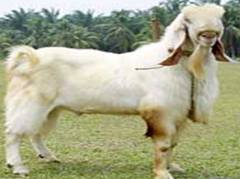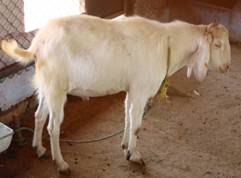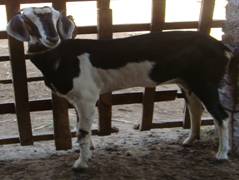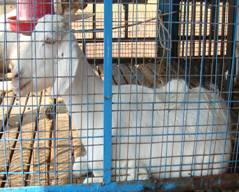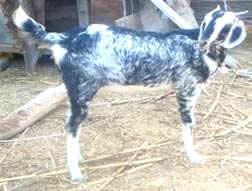 |
|||||||
| Major Activities |
Live Stock :: Goat :: Breeds of Goat |
||||||
BREEDS OF GOAT
Tellicherry Jamnapari Selam karupu Kanni
Boer Kodi |
|||||||
Technologies |
|||||||
Veterinary Services |
|||||||
Goats Breeds - Indian Himalayan - Region (Hilly tract) Himalayan breed: The goats of this breed are white haired and sturdily built. The breed is also known as gaddi, jamba, kashmiri according to their localities where they are reared. They inhabit kangra and kulu valleys, chamba, sirmur and Simla in Himachal pradesh and parts of Jammu hills. Castrated bucks are used for transporting merchandise in the hilly tracts. Pashmina: These are small dainty animals with quick movements. They are raised above 3400 m elevations in the Himalayas, Ladakh and Lahaul and spiti valleys. They produce the softest and warmest animal fibre used for high quality fabrics. The yield of pashmina varies from 75-150 g/goat. Chegu: This breed is found in the mountainous range of spiti, yaksar and Kashmir. The goats of this breed yield of pashmina, good meat and a small quantity of milk. Northern Region Jamnunapari: Native of Etawah district of Uttar Pradesh. These are large sized, tall, leggy with large folded pendulous ears and prominent Roman nose. They carry long and thick hair on their hind quarters and has a glossy goat. Horns are short flat. The body weight of adult bucks and does varies from 65 to 86 kg and 45-61 respectively. The average daily milk yield in 2.25 to 2.7 kg. The milk yield in a lactation period of, 250 days varies from 250 - 300 kg with 3.5 percent fat content. The Jamunapari goats have been used for evolving the famous Anglo -Nubian breed of goats in England. Beetal Barbari: This breed is found in Etawah, Etah, Agra and Mathura districts of U.P, kamal, Paniphat and Rothak in Hariyana, color varies with white, red and tan sports being common. These are small and short haired, with erect horns. Adult buck weighs from 36 - 45 kg and the doe from 27 -36 kg. They are usually stall fed and yield 0.90 to 1.25 kg of milk (fat 5%) per day in a lactation period of 108 days. They are prolific breeders and usually kid twice in 12 -15 months. This breed is highly fit for intensive rearing. Central region Berari: found in Nagpur and wardha district of Maharastra and Ninar district of Madhya Pradesh. These are tall and dark colored breeds. Doe yields about 0.6 kg of milk per day. Kathiiawari: This breed is native of Kutch, Northern Gujarat and Rajasthan. The goats have black coat with reddish color marks on the neck. The doe yields about 1.25 k.g of milk per day. Southern region Surti: Surti goats resemble Berari goats and possess white, short legs. Surti is popular in Bombay, Nasik and Surat. Does are good milk producers yielding 2.25 kg per day. Deccania or Osmanabadi: These have originated from a mixture of the goats of the plains. They are black, mixtures of white and black or red are also found. The milk yield is 1.4 to 2.25 kg per day. Malarbar (or) Tellicherry: found in Northern Kerala GBRI: This is a mixture of two more type of goats. The color is not uniform and may vary from black to white. The milk yield in is 0.9 to 2.8 kg/day. Eastern Region Bengal: The goats of this breed are found in 3 colours viz. Black, Brown and White. They are small short breeds. The meat of this breed is of superior quality. Bucks weigh 14-16 kg and nannies 9-14 kg. Does kids twice in a year, twins are common. The skin of Bengal goats are of excellent quality and is in great demand in India and abroad in foot-wear industry. Assam Hilly breed: These are smaller dwarf breeds of goats found in the hilly tract of Assam and other eastern states. Exotic Breeds Toggenberg: it is originated in the Toggenberg valley in north Switzerland. Skin is very soft and pliable. Usually both male and female are hornless. The adult doe weights 65 kg or more and the bucks more than 80 kg. Average milk production is 5.5 kg per day. The butter fat content of milk 3-4 percent. The male usually has longer hair than females. Sannen: Native of Sannen valley of Switzerland noted for its consistency and high production. Color is white or light cream. The face may be slightly dished and the ears point upward and forward. Both sexes are normally polled but sometimes horns do appear. Does weight 65 kg and the bucks 95 kg. Average milk yield is 2 - 5 kg per day during a lactation period of 8 -10 months. Milk fat 3 - 5%. Alpine: This breed was originated in Alps mountains. It was derived from French, Swiss and Rock Alpine breeds. No distinct color has been established. Excellent milkers and they have horns. Average milk yield is 2 - 3 kg with buffer fat of 3 -4%. Nubian: Originated in Nubia of North eastern Africa. Also found in Ethiopia and Egypt. It is a long legged and hardy animal. This breed along with Jamunapari of India together with native breeds of U.K. formed the cross bred Anglo Nubian breed of goat. Anglo Nubian: It is a big animal with a fine skin and glossy coat, -pendulous ears and Roman nose. Anglo Nubian is known as the Jersey cow of the goat world. Udder is large and pendulous with bigger teats. There is no fixed color. Bucks weight 65 - 80 kg and does from 50 -60 kg. Average milk yield in 3 - 4 kg/day. Peak yield may even go up to 6.5 kg or more. Angora: Originated in Turkey or Asia minor. It produces a superior quality fibre called mohair. The soft silky hairs cover the white body. If not shorn during spring the fleece drops off naturally as summer approaches. Average fleece yield is 1.2 kg. Good animals yields even up to 6 kg. The Angora is small in size with shorter legs. Horns are grey, spirally twisted and inclined backward and outward. Tail is short and erect. Conformation of a good milch goat: The general features of a good milkch goat are
Goats are one of the earliest discovery of mankind in prehistoric times as ready and easy source of meat. Whether in cold arid up hills, or hot arid deserts, or hilly tracts of mountains or ravines constituted of leached soil, goats have survived and sustained the poor people. The present worldwide distribution of goats shows that the number of milch type goats are more in the temperate zone and dual type or meat type goats are primarily located in the sub-tropical and tropical Asian and African countries. |
|||||||
| Home | Success Stories | Publication | Gallery | Forms | FAQs | Related Links | Contact | |
|||||||
| © All Rights Reserved. TNAU-2008. |
|||||||
